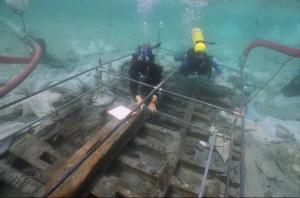Since the archaeological evidence from the early Islamic period that survived in the coastal area of the Land of Israel is scarce, the importance of the wreck increases

A shipwreck from the beginning of the eighth century AD with part of its contents found at Tantura Beach and studied by researchers from the Institute of Maritime Studies of the University of Haifa, is the only evidence so far of a vessel from the early Islamic period that sailed on the shores of the Mediterranean Sea.
"We have no historical or archaeological evidence about the economy and trade in this area during this period, and the ship may serve as a source of information for the social and economic activity in this area," said Dr. Yaakov Kahanov from the Institute of Maritime Studies and the Department of Maritime Civilizations at the University of Haifa.
The shipwreck itself was found about a decade ago in a survey conducted on Dor-Tantura beach by a joint expedition of the Institute for Maritime Archeology at Texas A&M University (INA) and the Institute for Maritime Studies at the University of Haifa. Through carbon testing it turned out that it originated in the eighth century. Now, at the end of another excavation season, the full picture of the 1300-year-old ship is beginning to emerge.
Apparently, it is a small ship about 15 meters long and about 5 meters wide that sailed along the shores of the Mediterranean Sea. It was found west of the shipping channel in the Dor-Tantura lagoon at a water depth of 0.75 meters and under a layer of sand, when the maximum depth of the site in the excavation was 2 meters below sea level.
According to Dr. Kahanov, this shipwreck is a rare find of a preserved vessel - both in terms of the amount of wood and its quality. "In addition to the wooden hull of the ship, the findings of the ship contained, among other things, about 30 pottery vessels. The assemblage of pottery includes eight amphoras, two pitchers and 20 storage jars that contained fish bones, ropes, mats, a bone needle, a wooden spoon, carved wooden parts, and food remains, mainly carobs and olives," he said.
"Since the archaeological evidence from the early Islamic period that survived in the coastal region of the Land of Israel is scarce, the importance of the wreck increases," the researcher stressed.
An ancient shipwreck that was built using a previous skeleton method was found at Dor Beach

4 תגובות
Registration of rights, and sale of models from the ship to museums and educational institutions in Islamic countries:
When the consideration will be paid through dignified gestures of a type of messages for peace (diplomatic relations), and more.
One of the most fascinating people I've met in my life is an archaeologist who dedicated his life to excavations there and his name is Kurt Reva.
Kurt is originally Dutch who built his home in Kibbutz Nachsholim, excavated the boat of "Jesus" from the Kinneret and built the glass museum in Nachsholim which curates all the treasures of the sea there. you will Read more here.
One of the biggest mysteries of Dor Beach are Napoleon's huge bronze cannons that sunk (according to Napoleon's diaries) in the place and have been looking for them for years.
For years, Kurt has been conducting fascinating tours of Dor's antiquities and the museum on weekends. You can call Kibbutz Nachshul and they will contact you. Recommended and fascinating. Kurt is a charming man who never runs out of stories. History, archaeology, the wonders of the Israeli bureaucracy as only those who come from outside and are gifted with healthy irony can describe.
Also, those with a diving license should visit during the excavation season. Ask the company there and maybe you can also volunteer in underwater excavations.
A lifetime experience. There is nothing like touching history with your bare hands.
I was happy to take part in the excavations, and I am happy that the publication was finally approved.